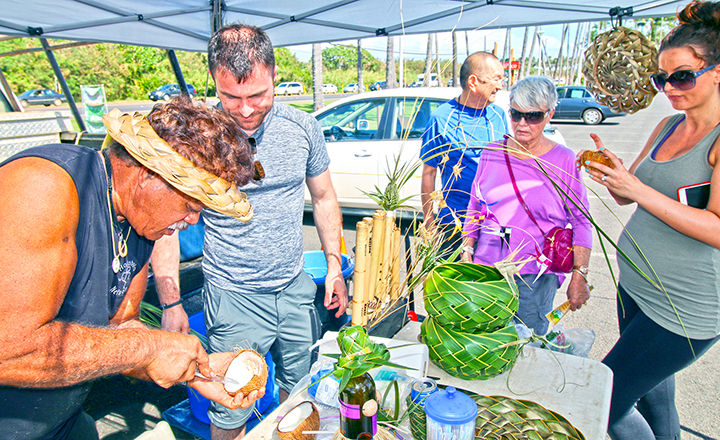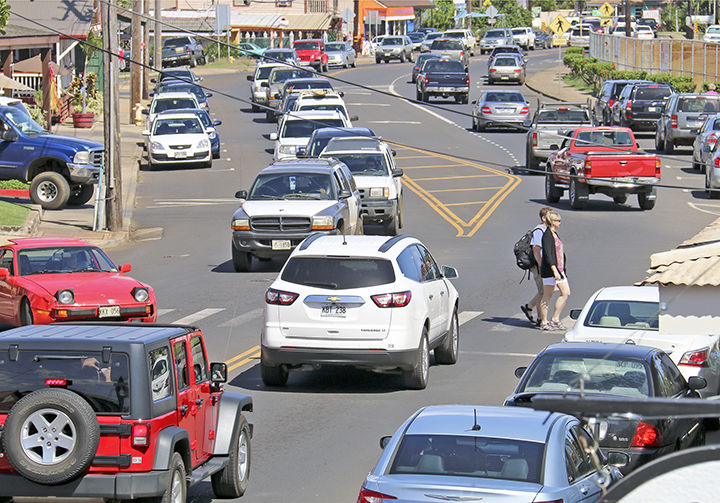Grinding gridlock
LIHUE — For years, residents along the Royal Coconut Coast say they have heard their fair share of solutions that may help to alleviate the constant traffic gridlock that residents and visitors alike encounter each day.
Many, however, say they are still waiting for relief.
Julian Riskus, who helps run the Hula Girl resort wear store in Old Kapaa Town, said the traffic along Kuhio Highway through downtown Kapaa “keeps getting worse and worse.”
“I don’t think it has impacted business, because if people come to Kapaa to shop, they’re going to park and walk up and down the street, but I think it mostly affects commuters who travel through,” Riskus said. “Visitors try to get to the North Shore or elsewhere but they can’t, and people who live here can’t get anywhere.”
Wailua Homesteads resident Bart Walton said he and his family must plan their day to avoid going through Kapaa between 10 a.m. and 6:30 p.m. on any given day.
“I wonder if people really know what it’s like — we live in Wailua Homesteads and there’s only two ways to get out of where we live to get to other parts of the island, and both of them, at certain times of the day, are so congested that we make up our minds to not even go anywhere,” Walton said. “I mean, I do everything I need to do before 11 in the morning, or 10, if I can, because there are times when you don’t even want to go down the hill.”
Kapaa resident Meg Schofield said she has, over the past several years, also “witnessed increasing traffic jams and gridlock that have literally caused us to have to abandon journeys to Lihue for work, appointments, services, shopping, etc.”
More congestion?
Schofield and Walton are among a growing chorus of residents calling for further infrastructure improvements to be made along the Kapaa corridor now that plans for several large developments, including the Coco Palms Resort by Hyatt, Coconut Beach Resort and HoKua Place subdivision, are coming down the pipeline.
“I’m not anti-development and I’m not anti-housing — I know how scarce it is on the island — but it’s clearly making such an impact on people’s lives already,” Schofield said. “I’m certainly not an expert in development infrastructure, but I just think it’s common sense to look at the number of issues that are out there, but the traffic, of course, is the most significant one for me.”
No quick fix
Developers, along with county and state officials, say solving those issues will come neither cheap nor easy.
“Improving our roadway infrastructure is imperative, especially for East Kauai,” Wailua-Kapaa Neighborhood Association Chair Rayne Regush wrote in an email. “Despite a growing resident and visitor population, limited financial resources, and several large developments pending, we’re still hopeful that state and county agencies will be implementing some less costly traffic solutions in the near future to help solve some of the worst traffic bottlenecks.”
Between 2010 and 2013, the population on Kauai and Niihau experienced a 3.6 percent bump to 69,512 from 67,090, according to U.S. Census Bureau data.
During that same time, the annual number of visitors to Kauai jumped by 15.5 percent, to 1.1 million from 964,724.
If current trends stay on track, the population on Kauai may reach 75,600 by 2020, 84,400 by 2030, and 93,000 by 2040, state Department of Business, Economic Development and Tourism officials wrote in a 2012 report.
Future Kapaa developments
Greg Allen, a minority partner in the HoKua Place subdivision that is slated to create 86 single-family homes and 683 multi-family units in 57 townhouse buildings on 97 acres of vacant agricultural lands behind Kapaa Middle School, said future development along the Kapaa corridor will likely impact traffic to some degree but explained that other factors must be considered as well.
The proposed project sits before the state Land Use Commission, which will be charged with determining whether the 97 acres of agricultural lands should be redesigned for urban use.
“Of course development has an impact on traffic, but tourism has an impact on traffic, too, and so does urban sprawl and so does kamaaina families growing,” Allen said. “We can’t put our heads in the sand and say there’s not going to be growth — there are going to be people who come here and are born here, so we have to plan for it.”
Allen said he and other project developers are willing to turn over all of their road improvements to the county and state once all the entitlements are in place.
The donations would include HoKua Street, a proposed new road that would bisect the development and connect the Kapaa Bypass Road to Olohena Road right above the middle school, and the length of the Kapaa Bypass Road owned by HoKua Place developers, which stretches from the Olohena Road roundabout to the first bypass bridge.
Allen said HoKua Place developers are also willing to donate additional land along their section of the bypass road to the DOT for future road improvements.
“Development should improve infrastructure equal to the amount of burden they put on infrastructure or greater,” Allen said. “The problem with Kapaa is that the traffic is extremely bad and the people have been hearing for a long time that things were going to change and they’re skeptical.”
Coco Palms traffic
Chad Waters, principal for Coco Palms Hui, LLC, the Honolulu-based development company that’s seeking to reconstruct, restore and rebuild the 350-room Coco Palms Resort in Wailua, declined to comment for this story.
That project will be considered on Tuesday by the county Planning Commission, which is charged with approving the building permits for the resort.
During a Planning Commission meeting last week on the proposed $135 million project, fellow Coco Palms Hui LLC principal Tyler Greene said he and Waters were working with Hyatt Hotels Corporation officials to create an airport shuttle service and a “green package” that would provide guests with free bike rentals to use for nearby commutes and free tour services to the North and South Shore areas.
“We understand that, if you’re a guest and you’re fighting traffic to get in and fighting traffic to get out, it can be stressful when you’re on vacation,” Greene said. “Furthermore, if you live here and you have guests coming who are coming there on a temporary basis and adding to the traffic, it’s stressful for them, too.”
Greene said they are also exploring whether it would be feasible to launch a regional shuttle service for hotel guests to the Wailua and Kapaa area that is similar to the pilot shuttle service running between North Shore resorts and popular visitor destinations in Princeville, Hanalei, Wainiha, Haena and Kee.
“We really want to educate people who come to Kauai by showing them that you don’t have to be reliant on a car,” Greene said. “What we’re seeing is that there are generations of people, whether they be younger than me or older than me, who are starting to see that we don’t have to rely so much on cars and we can get away from that kind of thought process.”
Road relief
County Deputy Engineer Lyle Tabata said officials are starting the design phase for a project on Kawaihau, Hauaala and Mailihuna roads near Kapaa Elementary School and Kapaa Middle School.
“This project largely involves safe routes to school and complete streets elements, but will include improvements to relieve congestion and improve safety at the five-way intersection of these three roads,” Tabata wrote in an email.
Three county departments, he added, are also working with state Department of Transportation officials on developing a comprehensive study that is “evaluating more than 40 possible transportation projects to identify short-term, mid-term, and long-term projects that will relieve congestion in the Kapaa area.”
Kapaa Business Association Secretary Bob Bartolo said the Eastside organization and the Wailua-Kapaa Neighborhood Association were asked by state Department of Transportation officials to prioritize planned road infrastructure projects for the Kapaa corridor.
Details of those discussions, he said, should be released within the next few weeks.
“In December, there were 100,955 visitors on Kauai and that’s going to continue to grow, so what are you going to do?” Bartolo said. “That’s one of the reasons why there is so much traffic on the road. The plans that the DOT created for traffic movement have been set up for a population of 30,000 — we’re already over 60,000 and we know something has to be done but we’re prioritizing because of money.”
Riskus, who helps run the Hula Girl store in Kapaa, said state and county officials should “widen the road, make an alternate route, or work on the public transit system.”
“Having one bus come by here once an hour is virtually useless,” Riskus said. “If there were buses running every 10 minutes or trolleys like in Waikiki that visitors could jump on instead of driving rental cars and clogging up the roads, that may make a difference.”
In the meantime, however, Allen said the best thing for commuters to do is exercise some patience.
“We all, as citizens, are in a rush and in a hurry,” Allen said. “We want to see things done a long time ago, but that doesn’t mean that the county folks haven’t been trying to make it happen — they are going to make it happen. Our state guys, our roadway guys, are also making strides — you can see it everyday as you drive through Lihue and Puhi. Things are happening. Kapaa’s next on the list, so hang on, be patient, it’s happening.”
•••
Darin Moriki, county government reporter, can be reached at 245-0428 or dmoriki@thegardenisland.com.




